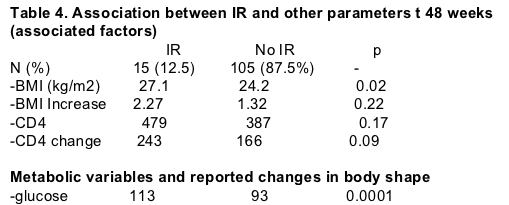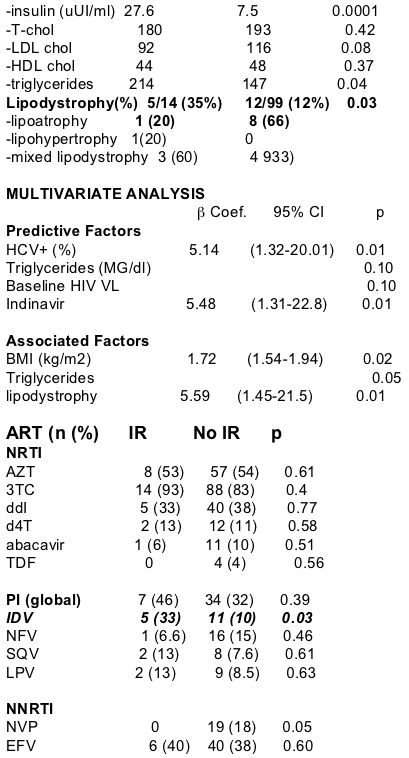 |
 |
 |
| |
Prospective Study of Glucose Metabolism in Antiretroviral Naive HIV-Infected Patients: Incidence of Insulin Resistance at 48 Weeks of HAART
|
| |
| |
Reported by Jules Levin
ICAAC Dec 17 2005, Wash DC
"........In our study, HOMA increased in the first year of HAART, leading to an insulin resistance incidence of 13%. The development of insulin resistance was related to BMI, HCV coinfection, indinavir use, and lipodystrophy development....."
Of interest, nevirapine was associated with NOT having insulin resistance, it was the only ART drug NOT associated with having insulin resistance. Indinavir was the only ART associated with having insulin resistance.
Nevirapine: 0 patients on NVP developed insulin resistance. 19 patients were on NVP & did not develop IR (18%) (0.05).
Indinavir: 5 (33%) patients taking IDV developed IR, 11 taking IDV did not developed IR (10.4%) (0.03).
Comment by Jules Levin: Insulin Resistance is a much more serious condition than one may think. This study is one of the very few studies estimating incidence of insulin resistance. The implications of these findings are clear and in line with what I’ve been saying: insulin resistance can be expected to be the cause of a number of complications in the future as people with HIV age and is a risk factor in causing many health conditions including diabetes and heart disease, and fatty liver which is associated with liver disease (fibrosis). If you have HCV or HBV fatty liver can become a more serious problem.
Authors: R. PALACIOS1, N. MERCHANTE 2, J. MACÍAS 2, M. MÁRQUEZ 1, J. PINEDA 2, J. SANTOS 1;
1Hosp. Virgen de la Victoria, Málaga, Spain, 2Hosp. de Valme, Sevilla, Spain.
STUDY
Patients starting HAART: 198
Patients satisfying inclusion criteria: 137
Patients with baseline IR: 17
Patients analyzed: 120
Introduction
HAART is associated with the lipodystrophy syndrome, which includes abnormal fat redistribution, dyslipidemia, and glucose metabolism disorders. Cross-sectional studies have reported a prevalence of diabetes mellitus (DM) of 2-7% among HIV-infected patients on HAART, and an additional 35% have imoaired glucose tolerance (1-6). Insulin resistance (IR) has been reported in 61% of HIV-infected patients on protease inhibitors (PI) (7), however, no prospective studies have analyzed the incidence of IR in HIV population. Most data on the development of glucose disorders in HIV-infected patients are from population-based studies (4,5,8) and the pathogenesis of these disorders remains to be defined (9). Awareness of the incidence and risk factors for IR in these patients would aid in the prevention and management of glucose disorders.
ABSTRACT
Background: glucose metabolism disorders have been reported in HIV-infected patients on HAART, mainly on PI. Our aim was to study glucose metabolism in naive HIV patients starting HAART and to analyse the incidence of insulin resistance (IR) and factors related to its development. All HIV+ patients who started HAART between June 2002 and Jan 2003 were screened for the study.
Methods: prospective, observational study of a cohort of HIV patients from two institutions starting HAART and maintaining the same regimen during the follow-up. Exclusion criteria: pregnant and breast feeding women, alcohol or illegal drugs abuse, current opportunistic infections, and treatment with drugs which modify glucose metabolism. Fasting samples were collected at entry, and at 48 weeks. Glucose and insulin levels were measured and IR by HOMA index was calculated. Patients with baseline IR were excluded for analysis. Statistic program: SPSS®10.0. IR was defined as a HOMA value >3.8.
Results:
among all patients, 17 (12.4%) had IR at entry.
120 patients were then analysed. Men 91, mean age 38 years.
Aids cases: 47. HCV coinfection: 43. Baseline mean BMI 23.1 kg/m2, CD4 cells count 219/mL, and HIV VL 5.15 log10.
HAART was started with PI (n=44), NNRTI (n=65), and only NRTI (n=11).
At 48 weeks, glucose (95 vs 90 mg/dl, p 0.0001), insulin levels (10.1 vs 7.2 _UI/ml, p 0.002), and HOMA increased (2.5 vs 1.6, p 0.002).
Fifteen (13%) patients developed IR (HOMA-IR >4) at 48 weeks of HAART.
In the multivariate analysis, IR was associated with a higher BMI (_ coefficient 0.83, CI95% 0.72-0.95; p=0.008), HCV coinfection (_ coefficient 4.6, CI95% 1.002-21.8; p=0.049), indinavir use (_ coefficient 8.3, CI95% 1.7-40.6; p=0.008), but not PI, and lipodystrophy development (_ coefficient 5.9, CI95% 1.17-29.9; p=0.031).
Conclusions: In our study, HOMA increased in the first year of HAART, leading to an IR incidence of 13%. The development of IR was related to BMI, HCV coinfection, indinavir use, and lipodystrophy development.
The poster said patients were 95% adherent.
Patients were excluded from the study if they stopped HAART or switched from PI to NNRTI or vice versa during the study period. In be included in this analysis patients must have maintained the same ART regimen for 48 weeks.
Clinical, anthropometrical, and lab data were recorded at the start of HAART and at 48 weeks.
HCV positivity was associated with insulin resistance: 66% having HCV developed IR, 33% with HCV did not have IR (0.01).
BASELINE CHARACTERISTICS of the 120 patients
mean
75% men
38 yrs old
BMI (kg/m2): 23.1 (20.5-25.0)
Smokers: 65.7%
Family history of diabetes: 21%
Hiv risk: idu 41%; HTX 39%; HMX 37%
Hiv evolution 58 months
AIDS 39%
CD4 222
Mean VL 5.39 log
Chronic HCV infection 36%


References
1. Carr A et al, AIDS 1998;12:F51-F58
2. Walli R et al Annals of Internal Medicine 1998;129;837-838
3. Carr et al Lancet 1999;353; 2093-2099
4. Palacios R et al AIDS 2003; 17;933-935
5. Yoon C et al J Acquir Immune def Syndr 2004;37;1464-1469
6. Brown TT et al Archives of Internal Medicine 2005; 165;1179-1184
7. Tsiodras S et al Archives of Internal Medicine 2000;160;2050-2056
8. Howard AA et al Clinical Infectious Diseases 2003; 36; 1318-1323
9. Woerle HJ et al Diabetes 2003;52;918-925
|
|
| |
| |
|
 |
 |
|
|